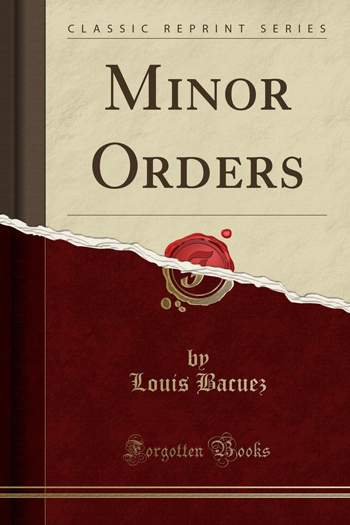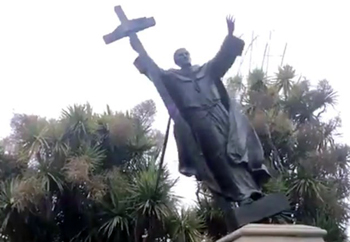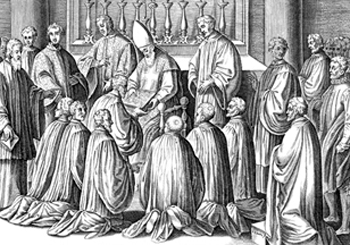Problemas Tradicionalistas
 |
 |
 |
 |
 |
 |
 |
Misa de diálogo - CX
Actitudes previas y posteriores al movimiento litúrgico hacia las órdenes menores
Cuando comparamos la visión tradicional de las Órdenes Menores con el trato que recibieron a manos de los reformadores litúrgicos en el siglo XX, se hace evidente que las dos posiciones contrastan enormemente entre sí. Para ilustrar este punto con mayor profundidad, volvamos a la exposición de las Órdenes Menores realizada por el P. Louis Bacuez, quien presentó modestamente su obra maestra de la siguiente manera:
 “Este pequeño libro es una secuela de uno que hemos publicado en Tonsura. ¡Que Dios conceda, que quienes lo utilizan puedan sentir un gran respeto por las Órdenes Menores y prepararse para ellas como deben! Las disposiciones con las que se acerquen a la ordenación serán la medida de las gracias que reciban, y de esta medida depende, en gran parte, el fruto que producirá su ministerio. Para tener una rica cosecha lo primero que se necesita es sembrar bien: Qui parce seminat parce et metet; et qui seminat in benedictionibus de benedictionibus et metet. (2 Cor. 9:6)” (1)
“Este pequeño libro es una secuela de uno que hemos publicado en Tonsura. ¡Que Dios conceda, que quienes lo utilizan puedan sentir un gran respeto por las Órdenes Menores y prepararse para ellas como deben! Las disposiciones con las que se acerquen a la ordenación serán la medida de las gracias que reciban, y de esta medida depende, en gran parte, el fruto que producirá su ministerio. Para tener una rica cosecha lo primero que se necesita es sembrar bien: Qui parce seminat parce et metet; et qui seminat in benedictionibus de benedictionibus et metet. (2 Cor. 9:6)” (1)
Cuando escribió estas palabras, percibió muy poco, que todo vestigio de respeto hacia las Órdenes Menores se vería borrado por los esfuerzos coordinados de los progresistas, con una actitud negativa y desdeñosa hacia ellas y que el Movimiento Litúrgico, que acababa de comenzar cuando publicó su libro, sería dominado por liturgistas influyentes que discutían cómo derrocarlos.
Mucho antes de que se inventara el término "Cultura de Cancelación", presentaron a las Órdenes Menores como una forma de opresión basada en la clase, perpetrada por una "casta" clerical y como una forma de legalismo espiritualmente vacío, y se esforzaron por hacer que parecieran ridículos.
Lejos de mostrar el debido respeto, esto implica un grado bastante considerable de desprecio, no solo por las generaciones de seminaristas que se formaron dentro de esta tradición, sino también por la integridad de la gran institución de Órdenes Menores que había servido a la Iglesia desde tiempos apostólicos. De hecho, su animosidad contra las Órdenes Menores era tan grande que estaban ansiosos de despojarlos de su naturaleza esencial de funciones de la Jerarquía y convertirlos en ministerios laicos.
A un Árbol se le Conoce por sus Frutos.
Estas entonces, fueron las disposiciones llenas de odio que inspiraron la reforma progresista, y determinarían las gracias recibidas y el fruto a producir por quienes ejercen los nuevos “ministerios” laicos en contraposición y en lugar de las tradicionales Órdenes Menores.
El P. Bacuez, que escribió su libro en el pontificado de San Pío X, nunca pudo, por supuesto, haber imaginado la desaparición de las Órdenes Menores, y mucho menos a manos de un futuro Papa. Le preocupaba que no se perdiera ni la más mínima cantidad de gracia en las almas de los que se preparan para el sacerdocio:
 “Veremos, en el Día Postrero, el daño que un ordenando se hace a sí mismo y el perjuicio que causa a las almas al perder, por su propia culpa, una parte de las gracias destinadas a santificar su sacerdocio y hacer fructíferos los campos de los cielos. Padre: Modica seminis detractio non est modicum messis detrimentum. (San Bernardo) ”(2)
“Veremos, en el Día Postrero, el daño que un ordenando se hace a sí mismo y el perjuicio que causa a las almas al perder, por su propia culpa, una parte de las gracias destinadas a santificar su sacerdocio y hacer fructíferos los campos de los cielos. Padre: Modica seminis detractio non est modicum messis detrimentum. (San Bernardo) ”(2)
Sin embargo, no necesitamos esperar hasta el Último Día para ver los efectos de una reforma que deliberadamente impide, como mediante un acto de anticoncepción espiritual, que las gracias sobrenaturales de las Órdenes Menores alcancen su fin dado por Dios: “santificar el sacerdocio y hacer fructíferos los campos del Padre Celestial". Porque la evidencia está a nuestro alrededor de que el árbol de esta reforma produjo frutos podridos.
Primero, notamos un debilitamiento de la estructura jerárquica de la Iglesia y una difuminación de la distinción entre clero y laicado; segundo, una esterilidad "anticonceptiva" que resulta en vocaciones marchitándose en la vid y por debajo del nivel de reemplazo, seminarios e iglesias cerrando, parroquias muriendo y el declive en la vida de la fe católica tradicional como se ve en todos las estadísticas medibles. La conclusión es ineludible: los que plantaron este árbol y los que ahora participan en la reforma son cómplices de una obra destructiva.
Ventajas de las Órdenes Menores
Una parte sustancial de la exposición del P. Bacuez sobre las Órdenes Menores está dedicada a los inestimables beneficios que aportan a la Iglesia. Esta los dividió en las siguientes tres categorías:
Una significativa y muy oportuna omisión, fue la de hacer cualquier mención a la participación activa de los laicos en la liturgia. El silencio del P. Bacuez sobre este tema es una declaración elocuente de la mente de la Iglesia, acerca de que la liturgia es dominio exclusivo del clero.
Ahora tomaremos cada uno de sus puntos por turno.
1. El Honor del Sacerdocio
“Una imagen, por perfecta que sea, nunca será apreciada por la mayoría de la gente, a menos que se coloque en un pedestal adecuado. Asimismo, el pontificado, que es la perfección del sacerdocio, no inspiraría a los fieles toda la estima que merece, si no tuviera como base, para darle la debida preeminencia, a estas diferentes clases de ministros subordinados, clases inferiores unas a otras, la menor de las cuales, sin embargo, es superior a cualquier orden de laicos".(3)
 Es un ejemplo de ironía dramática que el P. Bacuez, sin saberlo, haya elegido la figura literiaria de una estatua sostenida por un pedestal para ilustrar su argumento. El no sabía que las estatuas de personajes históricos se convertirían en una fuente importante de controversia en las guerras culturales y las políticas de identidad de nuestra época.
Es un ejemplo de ironía dramática que el P. Bacuez, sin saberlo, haya elegido la figura literiaria de una estatua sostenida por un pedestal para ilustrar su argumento. El no sabía que las estatuas de personajes históricos se convertirían en una fuente importante de controversia en las guerras culturales y las políticas de identidad de nuestra época.
Tampoco podía haber previsto que derribar monumentos, tanto metafóricos como concretos, se convertiría en un deporte favorito de los reformadores litúrgicos del siglo XX, cuyo objetivo era exaltar el estatus de los laicos mediante la “participación activa”, ”en las funciones del oficio. Y nunca, ni en su imaginación más delirante hubiera sospechado que un futuro Papa se uniría a la juerga iconoclasta para demoler las Órdenes Menores sobre las que escribió con evidente orgullo y convicción.
'No Pongas al Sacerdote en un Pedestal'
Sin embargo, los revolucionarios consideraron que la estima por la Jerarquía y el reconocimiento de su superioridad sobre los miembros laicos de la Iglesia eran demasiado objetables para permitirles sobrevivir en la sociedad moderna. El consenso de opinión entre ellos era que el clero y los laicos eran iguales debido a su Bautismo compartido, y colocar al sacerdote en un pedestal no solo era innecesario, sino que perjudicaba los intereses de los laicos.
"No pongas al sacerdote en un pedestal", fue su grito de batalla. Es el estribillo constante que todavía circula entre los progresistas que se niegan a dar el debido honor al sacerdocio e insisten en acusar a la Iglesia de “clericalismo” sistémico.
Pero el punto fundamental de las Órdenes Menores -y del Subdiaconado- era precisamente ser el pedestal sobre el que se apoya y se eleva el sacerdocio a una posición de honor en la Iglesia. Cuando la Ministeria quaedam de Pablo VI desmanteló los cimientos institucionales de la Jerarquía, el imponente pedestal y las columnas que eran las Órdenes Menores y el Subdiaconado ya no pudieron sostener y elevar el sacerdocio.
Los Fundamentos Bíblicos de las Órdenes Menores
P. Bacuez hizo uso del siguiente pasaje del Libro de Proverbios:
“La sabiduría se construyó una casa; Siete columnas labró. Ha matado a sus víctimas, ha mezclado su vino y ha dispuesto su mesa". (9: 1-2)
 Hizo una analogía entre “las siete columnas del templo viviente, que la Sabiduría Encarnada elevó a la Divina Majestad” y todas las Órdenes clericales (cuatro Menores y tres Mayores) que existen para el culto correcto de Dios. En esto, estaba completamente justificado. Porque, en su interpretación de este pasaje, los Padres de la Iglesia coinciden en que es una premisa del Santo Sacrificio de la Misa realizado, como dijo San Agustín, por “el Mediador del Nuevo Testamento mismo, el Sacerdote según el orden de Melquisedec". (4)
Hizo una analogía entre “las siete columnas del templo viviente, que la Sabiduría Encarnada elevó a la Divina Majestad” y todas las Órdenes clericales (cuatro Menores y tres Mayores) que existen para el culto correcto de Dios. En esto, estaba completamente justificado. Porque, en su interpretación de este pasaje, los Padres de la Iglesia coinciden en que es una premisa del Santo Sacrificio de la Misa realizado, como dijo San Agustín, por “el Mediador del Nuevo Testamento mismo, el Sacerdote según el orden de Melquisedec". (4)
En la reforma de 1972, no menos de cinco (5) de las siete columnas se derrumbaron de sus nichos en la Jerarquía a gritos de "clericalismo institucionalizado", "delirios de grandeza" y "prejuicios inconscientes" contra los laicos.
Para dilucidar aún más la afinidad de las Órdenes Menores con el sacerdocio, el P. Bacuez brindó una breve descripción de la cursus honorum que comprendía las Órdenes de Ostiario, Lector, Exorcista, Acólito, Sub-Diácono, Diácono y Sacerdote antes de continuar explicando su interrelación:
“Estos siete poderes conferidos sucesivamente, comenzando por el último, se superponen uno sobre otro sin desaparecer ni entrar en conflicto, de modo que en el sacerdocio, el más alto de todos, se resumen todos. El sacerdote los une a todos en su persona y debe ejercerlos durante toda su vida en los distintos oficios de su ministerio”. (6)
Sin embargo, después de Ministeria quaedam, estos derechos y poderes ya no se consideran la posesión personal única de los ordenados, sino que se han redistribuido oficialmente entre los bautizados. No se trataba simplemente de cambiar el título de Órdenes a "ministerios": el verdadero fin de la revolución fue tomar los privilegios de las "clases dominantes" (los representantes de Cristo Rey) y dárselos a sus súbditos (los laicos) como un "derecho".
El mensaje neomarxista era, y sigue siendo, que se trataba de un acto de "justicia restaurativa" para los laicos que habían sido "históricamente agraviados". Para los progresistas litúrgicos, 1972 fue, aparentemente, el año de la "compensación".
Continuará

Comenzando la disminución del respeto por las Órdenes Menores...
Cuando escribió estas palabras, percibió muy poco, que todo vestigio de respeto hacia las Órdenes Menores se vería borrado por los esfuerzos coordinados de los progresistas, con una actitud negativa y desdeñosa hacia ellas y que el Movimiento Litúrgico, que acababa de comenzar cuando publicó su libro, sería dominado por liturgistas influyentes que discutían cómo derrocarlos.
Mucho antes de que se inventara el término "Cultura de Cancelación", presentaron a las Órdenes Menores como una forma de opresión basada en la clase, perpetrada por una "casta" clerical y como una forma de legalismo espiritualmente vacío, y se esforzaron por hacer que parecieran ridículos.
Lejos de mostrar el debido respeto, esto implica un grado bastante considerable de desprecio, no solo por las generaciones de seminaristas que se formaron dentro de esta tradición, sino también por la integridad de la gran institución de Órdenes Menores que había servido a la Iglesia desde tiempos apostólicos. De hecho, su animosidad contra las Órdenes Menores era tan grande que estaban ansiosos de despojarlos de su naturaleza esencial de funciones de la Jerarquía y convertirlos en ministerios laicos.
A un Árbol se le Conoce por sus Frutos.
Estas entonces, fueron las disposiciones llenas de odio que inspiraron la reforma progresista, y determinarían las gracias recibidas y el fruto a producir por quienes ejercen los nuevos “ministerios” laicos en contraposición y en lugar de las tradicionales Órdenes Menores.
El P. Bacuez, que escribió su libro en el pontificado de San Pío X, nunca pudo, por supuesto, haber imaginado la desaparición de las Órdenes Menores, y mucho menos a manos de un futuro Papa. Le preocupaba que no se perdiera ni la más mínima cantidad de gracia en las almas de los que se preparan para el sacerdocio:

Frutos contaminados de un árbol enfermo
Sin embargo, no necesitamos esperar hasta el Último Día para ver los efectos de una reforma que deliberadamente impide, como mediante un acto de anticoncepción espiritual, que las gracias sobrenaturales de las Órdenes Menores alcancen su fin dado por Dios: “santificar el sacerdocio y hacer fructíferos los campos del Padre Celestial". Porque la evidencia está a nuestro alrededor de que el árbol de esta reforma produjo frutos podridos.
Primero, notamos un debilitamiento de la estructura jerárquica de la Iglesia y una difuminación de la distinción entre clero y laicado; segundo, una esterilidad "anticonceptiva" que resulta en vocaciones marchitándose en la vid y por debajo del nivel de reemplazo, seminarios e iglesias cerrando, parroquias muriendo y el declive en la vida de la fe católica tradicional como se ve en todos las estadísticas medibles. La conclusión es ineludible: los que plantaron este árbol y los que ahora participan en la reforma son cómplices de una obra destructiva.
Ventajas de las Órdenes Menores
Una parte sustancial de la exposición del P. Bacuez sobre las Órdenes Menores está dedicada a los inestimables beneficios que aportan a la Iglesia. Esta los dividió en las siguientes tres categorías:
- El honor del sacerdocio;
- La dignidad del culto;
- La perfección del clero.
Una significativa y muy oportuna omisión, fue la de hacer cualquier mención a la participación activa de los laicos en la liturgia. El silencio del P. Bacuez sobre este tema es una declaración elocuente de la mente de la Iglesia, acerca de que la liturgia es dominio exclusivo del clero.
Ahora tomaremos cada uno de sus puntos por turno.
1. El Honor del Sacerdocio
“Una imagen, por perfecta que sea, nunca será apreciada por la mayoría de la gente, a menos que se coloque en un pedestal adecuado. Asimismo, el pontificado, que es la perfección del sacerdocio, no inspiraría a los fieles toda la estima que merece, si no tuviera como base, para darle la debida preeminencia, a estas diferentes clases de ministros subordinados, clases inferiores unas a otras, la menor de las cuales, sin embargo, es superior a cualquier orden de laicos".(3)

Derribar estatuas se ha vuelto popular hoy:
arriba, Fray Junípero Serra en el centro de Los Ángeles, California
Tampoco podía haber previsto que derribar monumentos, tanto metafóricos como concretos, se convertiría en un deporte favorito de los reformadores litúrgicos del siglo XX, cuyo objetivo era exaltar el estatus de los laicos mediante la “participación activa”, ”en las funciones del oficio. Y nunca, ni en su imaginación más delirante hubiera sospechado que un futuro Papa se uniría a la juerga iconoclasta para demoler las Órdenes Menores sobre las que escribió con evidente orgullo y convicción.
'No Pongas al Sacerdote en un Pedestal'
Sin embargo, los revolucionarios consideraron que la estima por la Jerarquía y el reconocimiento de su superioridad sobre los miembros laicos de la Iglesia eran demasiado objetables para permitirles sobrevivir en la sociedad moderna. El consenso de opinión entre ellos era que el clero y los laicos eran iguales debido a su Bautismo compartido, y colocar al sacerdote en un pedestal no solo era innecesario, sino que perjudicaba los intereses de los laicos.
"No pongas al sacerdote en un pedestal", fue su grito de batalla. Es el estribillo constante que todavía circula entre los progresistas que se niegan a dar el debido honor al sacerdocio e insisten en acusar a la Iglesia de “clericalismo” sistémico.
Pero el punto fundamental de las Órdenes Menores -y del Subdiaconado- era precisamente ser el pedestal sobre el que se apoya y se eleva el sacerdocio a una posición de honor en la Iglesia. Cuando la Ministeria quaedam de Pablo VI desmanteló los cimientos institucionales de la Jerarquía, el imponente pedestal y las columnas que eran las Órdenes Menores y el Subdiaconado ya no pudieron sostener y elevar el sacerdocio.
Los Fundamentos Bíblicos de las Órdenes Menores
P. Bacuez hizo uso del siguiente pasaje del Libro de Proverbios:
“La sabiduría se construyó una casa; Siete columnas labró. Ha matado a sus víctimas, ha mezclado su vino y ha dispuesto su mesa". (9: 1-2)

Una ordenación a la orden menor de exorcistas, una de las siete columnas.
En la reforma de 1972, no menos de cinco (5) de las siete columnas se derrumbaron de sus nichos en la Jerarquía a gritos de "clericalismo institucionalizado", "delirios de grandeza" y "prejuicios inconscientes" contra los laicos.
Para dilucidar aún más la afinidad de las Órdenes Menores con el sacerdocio, el P. Bacuez brindó una breve descripción de la cursus honorum que comprendía las Órdenes de Ostiario, Lector, Exorcista, Acólito, Sub-Diácono, Diácono y Sacerdote antes de continuar explicando su interrelación:
“Estos siete poderes conferidos sucesivamente, comenzando por el último, se superponen uno sobre otro sin desaparecer ni entrar en conflicto, de modo que en el sacerdocio, el más alto de todos, se resumen todos. El sacerdote los une a todos en su persona y debe ejercerlos durante toda su vida en los distintos oficios de su ministerio”. (6)
Sin embargo, después de Ministeria quaedam, estos derechos y poderes ya no se consideran la posesión personal única de los ordenados, sino que se han redistribuido oficialmente entre los bautizados. No se trataba simplemente de cambiar el título de Órdenes a "ministerios": el verdadero fin de la revolución fue tomar los privilegios de las "clases dominantes" (los representantes de Cristo Rey) y dárselos a sus súbditos (los laicos) como un "derecho".
El mensaje neomarxista era, y sigue siendo, que se trataba de un acto de "justicia restaurativa" para los laicos que habían sido "históricamente agraviados". Para los progresistas litúrgicos, 1972 fue, aparentemente, el año de la "compensación".
Continuará
- Louis Bacuez SS, Órdenes menores, St Louis MO: B. Herder, 1912, p. X. “El que siembra escasamente, también segará escasamente; y el que siembra en bendiciones también segará bendiciones ".
- Ibid ., San Bernardo de Clairvaux, Sermón de Cuaresma sobre el salmo 'Qui habitat', Sermones de Tempore, In Quadragesima, Prefacio, § 1: “Si , al momento de la siembra, se ha perdido una cantidad moderada de semilla, el daño hecho a la cosecha no será despreciable ”.
- Ibíd. , pág. 6.
- San Agustín, La ciudad de Dios , libro XVII, cap. 20: "Del Reino y del Mérito de David; y de su hijo Salomón, y de esa profecía relativa a Cristo, que se encuentra o en los libros que se unen a los escritos por él, o en los que indudablemente son suyos".
- Estas fueron las cuatro Órdenes Menores y la Orden Mayor del Subdiaconado.
- L. Bacuez, op. cit., pág. 5.
Publicado el 4 de enero de 2022
______________________
______________________
 Volume I |
 Volume II |
 Volume III |
 Volume IV |
 Volume V |
 Volume VI |
 Volume VII |
 Volume VIII |
 Volume IX |
 Volume X |
 Volume XI |
 Special Edition |



